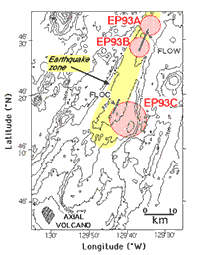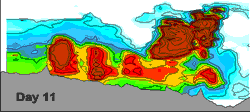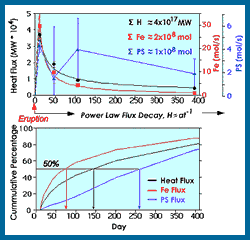1993:
CoAxial Segment Eruption
Juan de Fuca Ridge
 First
planned response to a submarine volcanic eruption: First
planned response to a submarine volcanic eruption:
The 1993
volcanic eruption along the CoAxial segment of the Juan de Fuca Ridge
was the first time a planned response to a submarine volcanic eruption
took place. It provided an opportunity to sample a hydrothermal system
as often and as early as possible following an event. This event produced
3 event plumes and initiated hydrothermal activity at 2 locations, Flow
and Floc.
We arrived at
the CoAxial eruption site only 11 days after the first seismic
activity, and returned several times within the first year. In many
respects we found a scene similar to that at Cleft in 1986.

Plume from the 1993 eruption, click for animation of plume evolution. |
Hydrothermal
plumes extended almost continuously along the 30 km strike of the dike injection.
Two event plumes overlaid the actual
eruption site. The movie below shows the vigorous hydrothermal plumes
generated by the eruption and their gradual decline during the first days,
months and years. By 1996, hydrothermal plumes had nearly disappeared.
First
integration of hydrothermal fluxes over the life cycle of a hydrothermal
system (1993-1996):
 We
monitored the CoAxial vent fields for three years before the hydrothermal
activity expired. We were able, for the first time, to quantify the flux
of heat and certain chemical species during the life of these hydrothermal
vent fields. These figures show results through the first year of monitoring:
the decline of heat and Fe fluxes follow a power law decay indicating
they are controlled by a purely physical process, the cooling of new magma.
Particulate S, on the other hand, follows a very different pattern, apparently
because of the influence of microbial processes in the shallow crust.
The lower graph emphasizes the necessity of early response to an eruption
event. 50% of the total Fe released during the 3-yr life of the CoAxial
vent field was released within ~2 months; 50% of the heat within 5 months.
The release of S took much longer because of the microbiological influence. We
monitored the CoAxial vent fields for three years before the hydrothermal
activity expired. We were able, for the first time, to quantify the flux
of heat and certain chemical species during the life of these hydrothermal
vent fields. These figures show results through the first year of monitoring:
the decline of heat and Fe fluxes follow a power law decay indicating
they are controlled by a purely physical process, the cooling of new magma.
Particulate S, on the other hand, follows a very different pattern, apparently
because of the influence of microbial processes in the shallow crust.
The lower graph emphasizes the necessity of early response to an eruption
event. 50% of the total Fe released during the 3-yr life of the CoAxial
vent field was released within ~2 months; 50% of the heat within 5 months.
The release of S took much longer because of the microbiological influence.
CoAxialPacific
Seismicity Theme Page | CoAxial
Geology Page
|



